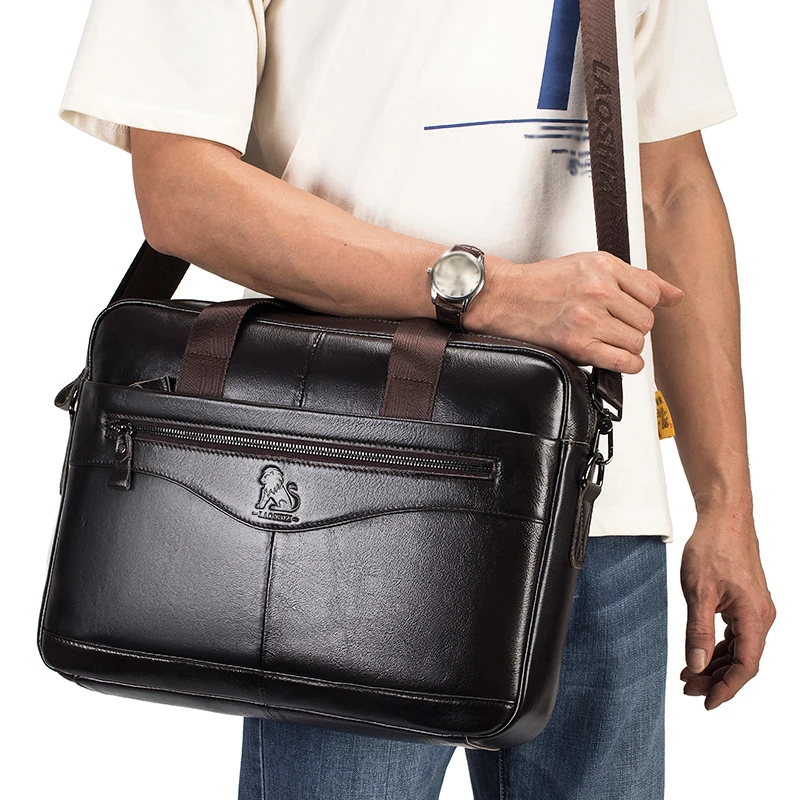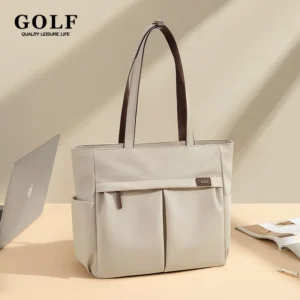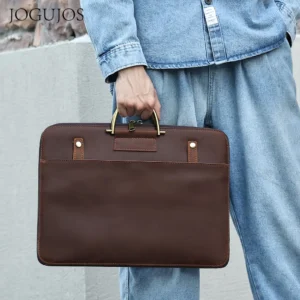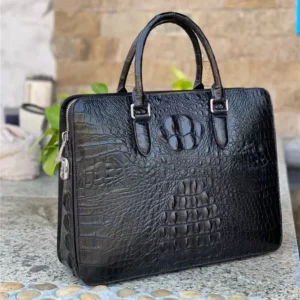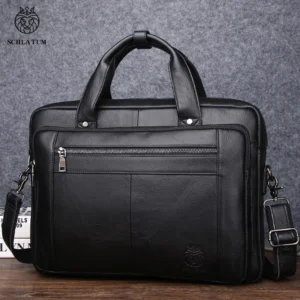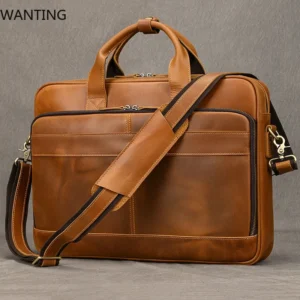When it comes to professional accessories, few items make as strong a statement as a high-quality leather briefcase. More than just a way to carry your documents and devices, a well-crafted leather briefcase is an investment that can last for decades—becoming more distinguished with age and telling the story of your professional journey. This guide will help you understand what makes a truly durable leather briefcase and how to select one that will stand the test of time.
Understanding Premium Leather Quality for Maximum Durability
The foundation of any durable leather briefcase starts with the quality of the leather itself. Not all leather is created equal, and understanding the differences is crucial when making a long-term investment.
The durability of leather is determined by several key factors:
– The density and orientation of the natural fibers
– The thickness of the hide
– The tanning process used to preserve and strengthen the material
Leather Grades and Their Durability
Full-grain leather represents the highest quality and most durable option available. This leather includes the entire top grain with its natural markings and tight fiber structure intact. Nothing is removed through sanding or buffing, preserving the hide’s natural strength. With proper care, foundational information on premium leather types confirms that full-grain leather briefcases often last 20+ years, developing a rich patina that enhances their appearance over time.
Top-grain leather is the second-highest quality option. It’s been lightly sanded to remove imperfections, making it more refined in appearance while still maintaining good durability. Though not as robust as full-grain, top-grain leather briefcases can still provide 10-15 years of reliable service when properly maintained.
Despite its misleading name, genuine leather is actually a lower grade made from the layers remaining after the top portions are split off. A detailed analysis of leather quality for briefcases shows it’s significantly less durable, often showing wear within just a few years.
Bonded leather should be avoided entirely for durability concerns. It’s manufactured from leather scraps bound together with adhesives and coated with a polyurethane layer, making it prone to peeling and cracking, often failing within months of regular use.
Leather Source and Tanning Methods
The animal source of leather significantly affects durability. Cowhide is the most common and offers a good balance of strength and flexibility. Buffalo leather provides exceptional durability due to its thicker fibers and natural elasticity, often outlasting cowhide in high-stress applications.
The tanning method also impacts longevity. Vegetable-tanned leather uses natural tannins from plant materials, resulting in a firm leather that develops a beautiful patina but requires more maintenance. Chrome-tanned leather, treated with chromium salts, offers better water and stain resistance but may not develop the same rich character over time.
Examining classic leather briefcases from quality makers can help you visually identify these differences in leather quality and understand how they translate to real-world durability.
Critical Construction Elements That Determine Briefcase Longevity
Even the finest leather will fail prematurely if the briefcase isn’t constructed properly. Several key elements determine how well a briefcase will hold up to daily use.
Stitching Quality
The stitching is quite literally what holds your investment together. Look for:
- Saddle stitching – a traditional hand method where each stitch is individually locked, meaning if one breaks, the entire seam won’t unravel
- Dense, even stitching – stitches should be small, tight, and perfectly spaced
- Quality thread material – nylon or polyester threads offer better durability than cotton
- Reinforced stitching at stress points – areas like handle attachments and corners should have extra stitches
Hardware Quality
Quality hardware significantly impacts a briefcase’s lifespan:
- Solid brass components offer exceptional durability and develop an attractive patina
- Stainless steel provides excellent strength and corrosion resistance
- Avoid zinc alloys that may look similar to higher-quality metals but will deteriorate more quickly
- Test the feel – quality hardware has a substantial weight and smooth operation
When choosing the perfect leather briefcase, pay special attention to stress point reinforcement. The best briefcases use metal rivets, corner protectors, or additional leather patches at points where strain occurs.
Edge Finishing and Interior Construction
Edge finishing prevents leather from fraying or separating over time. Well-finished edges are burnished, painted, or bound to seal and protect the raw edge of the leather.
The interior construction contributes significantly to structural integrity. Look for:
– Sturdy lining material (canvas or leather is preferable to thin fabric)
– Reinforced compartment dividers
– Properly attached interior pockets
Examining well-constructed leather bags can help you identify these quality indicators before making your purchase.
Warning signs of poor construction include visible glue, uneven stitches, plastic hardware, and edges that already show signs of wear or separation even when new.
Identifying High-Performance Hardware and Closures
Hardware is often the first component to fail on lesser-quality briefcases. Knowing what to look for can help ensure your briefcase stands up to years of use.
Zipper Quality
Zippers endure constant use and stress, making their quality paramount:
– YKK zippers are the industry standard for durability
– Metal zippers outlast plastic alternatives
– Look for tight, even teeth that mesh perfectly when closed
– Smooth operation without catching indicates quality
Buckles, Clasps and Locks
For briefcases with traditional closures:
– Solid brass or stainless steel buckles offer the best longevity
– Spring-loaded mechanisms should snap firmly and precisely
– Test the action multiple times to ensure smooth operation
– Lock mechanisms should engage securely without excessive play
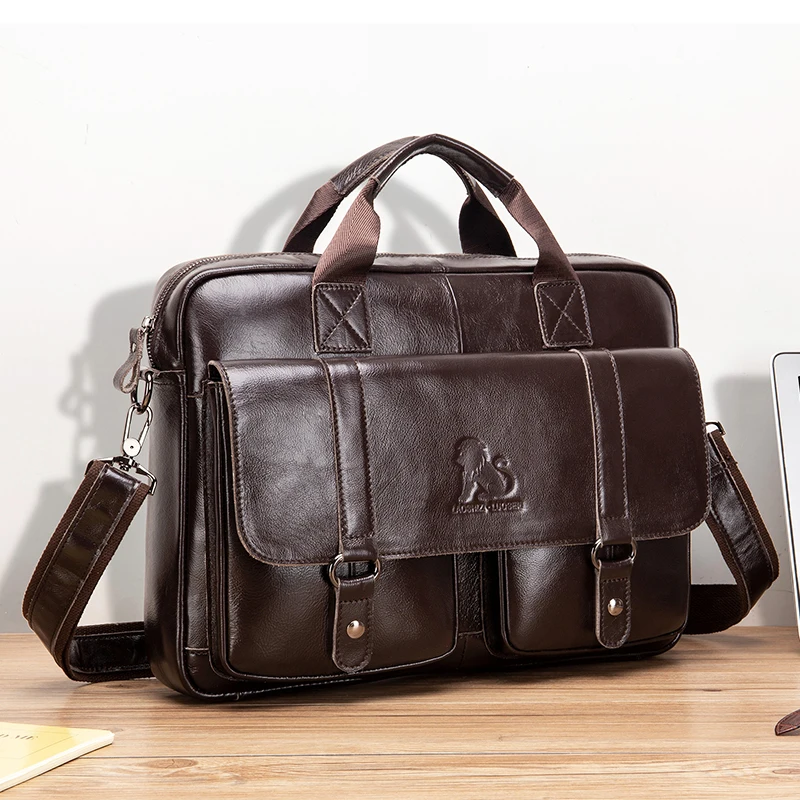
Handle and Strap Attachments
The way handles and straps connect to the bag is critical:
– Reinforced attachment points with extra leather layers
– Metal fixtures securing handles to the bag body
– Multiple rows of stitching around attachment points
– D-rings for shoulder straps should be firmly secured
Examining top-rated classic leather briefcases and men’s classic leather briefcases can provide visual examples of quality hardware implementation. When testing hardware in person, the weight and solid feel of metal components is often a reliable indicator of quality.
How to Evaluate Briefcase Handle and Strap Durability
Handles and straps are subject to the most stress during daily use, making them common failure points in inferior briefcases.
Handle Construction Methods
The construction method significantly impacts handle durability:
– Rolled handles – leather is rolled around a core material and stitched underneath, providing comfort and strength
– Wrapped handles – leather is wrapped around a rigid core and secured with adhesive and stitching
– Layered handles – multiple layers of leather are stitched together for reinforcement
– Edge treatment – burnished or painted edges prevent fraying and splitting
Material Considerations
While leather handles are traditional, their construction matters:
– Full-grain leather handles will outlast those made from lower grades
– The core material (if present) should be firm but not brittle
– Stitching should extend the full length of the handle attachment
For more examples of reinforced construction, browse our selection of leather laptop work totes that feature similar durability principles.
Testing Handle Strength
Before purchasing, perform these simple tests:
– Gently pull the handle away from the bag to check for give or weakness
– Feel for any movement in the attachment points when pressure is applied
– Check for reinforcement at the base of handles where they meet the bag
– Examine stitching for evenness and reinforcement
Common signs of premature wear include stretched leather at attachment points, loose stitching, or handles that feel flimsy when the bag is loaded.
The Expert’s Guide to Examining Leather Briefcase Craftsmanship
Knowing how to properly inspect a leather briefcase before purchasing can help ensure you’re making a worthy investment.
Step-by-Step Inspection Process
- Examine the leather – Look for tight grain, consistent color, and natural markings indicating full-grain quality
- Check all seams – Run your fingers along every seam, feeling for bumps, gaps, or loose threads
- Inspect the stitching – Look for even, tight stitches with no loose threads or skipped sections
- Test all hardware – Open and close each zipper, clasp, and lock several times to ensure smooth operation
- Examine stress points – Check reinforcement at corners, handle attachments, and the bottom of the bag
- Assess symmetry – A quality briefcase will have perfectly aligned components and even construction
- Check interior construction – Examine the lining attachment, pocket stitching, and divider construction
When making your assessment, the ideal leather briefcase will excel in each of these categories.
Weight Distribution
A well-designed briefcase distributes weight evenly when loaded:
– Place your typical daily items inside and carry the bag
– Notice if it pulls to one side or feels unbalanced
– Check if the handle placement allows for comfortable carrying when loaded
– Assess how the weight affects the structure of the bag
For professionals who carry their bags daily, proper weight distribution is essential for both comfort and preventing premature wear on durable leather bags for daily use.
Size and Functionality Considerations for Professional Needs
The size and organization of your briefcase affect not only its utility but also its longevity. Choosing the appropriate size for your needs prevents overstuffing, which stresses seams and closures.
Standard Dimensions for Professional Contexts
- Compact briefcases (15” x 11” x 4”) – Ideal for minimal essentials and smaller laptops
- Standard briefcases (16” x 12” x 5”) – Accommodate most business needs including documents and 15” laptops
- Expanded briefcases (17” x 13” x 6” or larger) – Suitable for those carrying larger devices or additional materials
Organization and Weight Distribution
The internal design significantly impacts durability:
– Multiple compartments distribute weight more evenly than a single large space
– Padded laptop sections prevent devices from shifting and stressing seams
– Document dividers keep contents organized and prevent distortion of the bag’s shape
– Pen holders and small pockets keep items secure rather than loosely moving inside
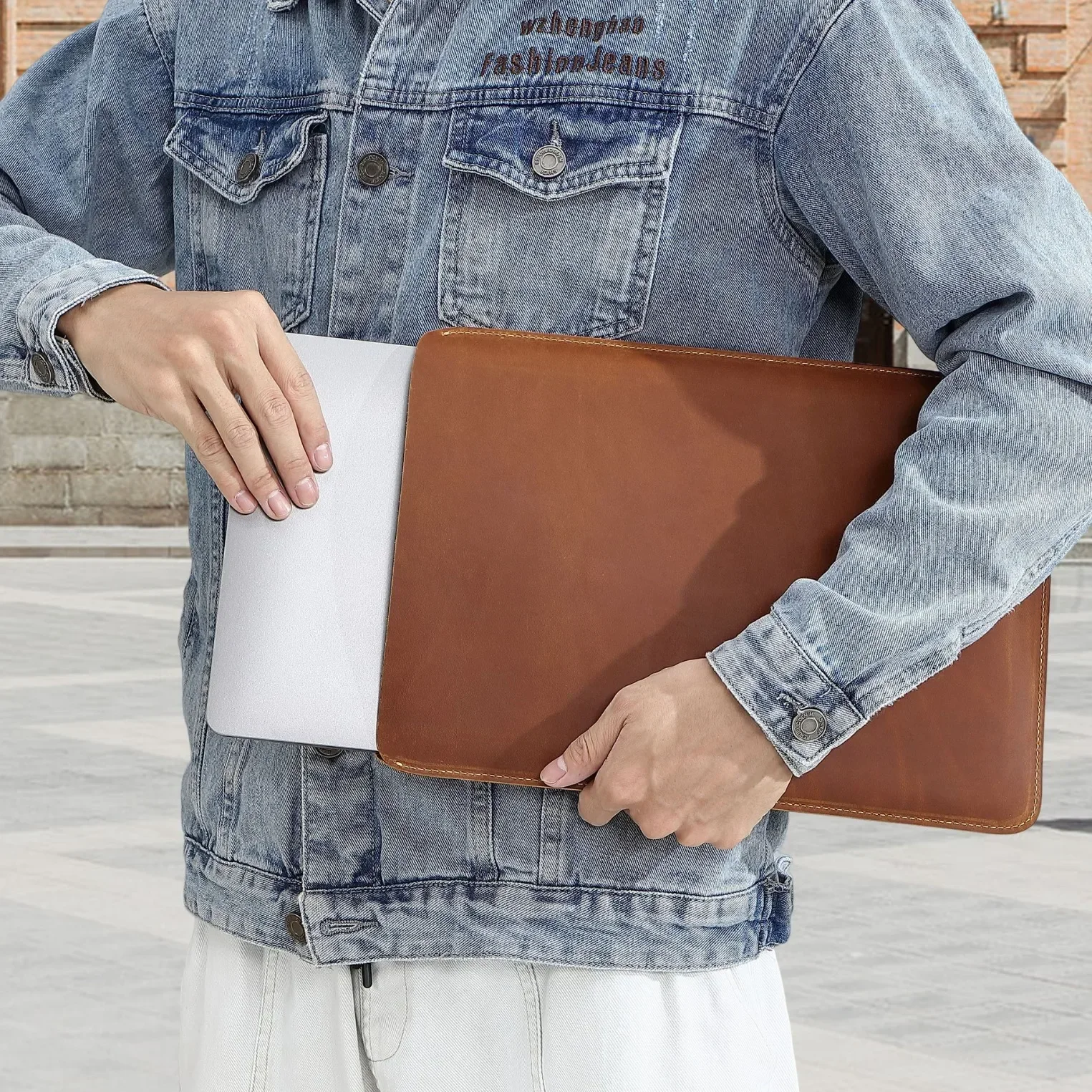
For professionals seeking the ideal balance between capacity and durability, our classic laptop briefcases offer thoughtfully designed organization features that help extend the life of the bag.
Investing in Quality: Price Ranges and Value Indicators
Understanding the relationship between price and quality helps set realistic expectations for your investment.
Price Range Breakdown
- Entry-level quality ($200-350) – May use top-grain leather with decent construction but often compromise on hardware quality or interior construction
- Mid-range quality ($350-600) – Generally offers full-grain leather, quality stitching, and good hardware with attention to detail
- Premium quality ($600-1,000) – Features exceptional materials, craftsmanship, hardware, and often handmade elements
- Luxury tier ($1,000+) – Incorporates the highest quality materials, traditional handcrafting methods, premium hardware, and brand heritage
Value Assessment
Price alone doesn’t guarantee quality. Look for these value indicators:
– Detailed information about leather source and tanning method
– Transparent description of construction techniques
– Reasonable warranty periods that reflect confidence in durability
– Brand reputation for quality rather than just marketing or fashion positioning
When considering your investment, remember that affordable quality leather briefcases offer the best value when they balance price with genuine durability features rather than aesthetic extras.
Men's Classic Leather Briefcase, Slim Leather Laptop Briefcase, Slim Leather Portfolio Briefcase
$93.67 Select options This product has multiple variants. The options may be chosen on the product pageLeather Laptop Work Tote, Tan Leather Work Tote, Women's Leather Work Tote, Zippered Leather Work Tote
Price range: $223.62 through $237.97 Select options This product has multiple variants. The options may be chosen on the product pageClassic Laptop Briefcase, Men's Classic Leather Briefcase, Slim Leather Attache Case
Price range: $353.50 through $360.81 Select options This product has multiple variants. The options may be chosen on the product pageBlack Leather Briefcase, Leather Document Bag, Men's Classic Leather Briefcase
Genuine Crocodile Leather Executive Briefcase with Password Lock – Premium Business Document Carrier$1,201.87 Select options This product has multiple variants. The options may be chosen on the product pageBlack Leather Briefcase, Classic Laptop Briefcase, Men's Classic Leather Briefcase, Slim Leather Laptop Briefcase
$228.72 Select options This product has multiple variants. The options may be chosen on the product pageBrown Leather Briefcase, Classic Laptop Briefcase, Crazy Horse Leather Satchel, Men's Classic Leather Briefcase
Price range: $172.15 through $200.02 Select options This product has multiple variants. The options may be chosen on the product page
Essential Care Practices to Extend Your Briefcase’s Lifespan
Even the highest quality briefcase requires proper maintenance to reach its full potential lifespan.
Regular Maintenance Routine
- Clean regularly – Wipe down with a slightly damp cloth weekly to remove dust and prevent buildup
- Condition appropriately – Apply leather conditioner every 3-6 months depending on climate and usage
- Address stains immediately – Blot (never rub) any spills as soon as they happen
- Protect from elements – Apply appropriate water protectant for your leather type
- Proper storage – Store in a dust bag or pillowcase when not in use for extended periods
Climate Considerations
Different environments require adjusted care routines:
– In humid climates, allow more air circulation to prevent mold
– In dry climates, condition more frequently to prevent cracking
– In variable climates, focus on proper water protection and regular conditioning
Learning how to maintain your leather briefcase properly is as important as the initial quality selection. Professional cleaning services can also be worth considering annually for high-end briefcases.
How Different Leather Finishes Affect Long-Term Performance
The finish applied to leather significantly impacts its durability, appearance, and maintenance requirements.
Common Leather Finishes
Aniline leather – Minimally processed with only dye and no surface coating, showing the natural grain and markings. Most natural looking but requires more care and develops the richest patina.
Semi-aniline leather – Light surface coating over dyed leather provides some protection while maintaining most natural characteristics. Offers a good balance of natural appearance and practical protection.
Pigmented (fully finished) leather – Heavier protective coating with added pigments provides maximum durability and stain resistance but limits the natural feel and patina development.
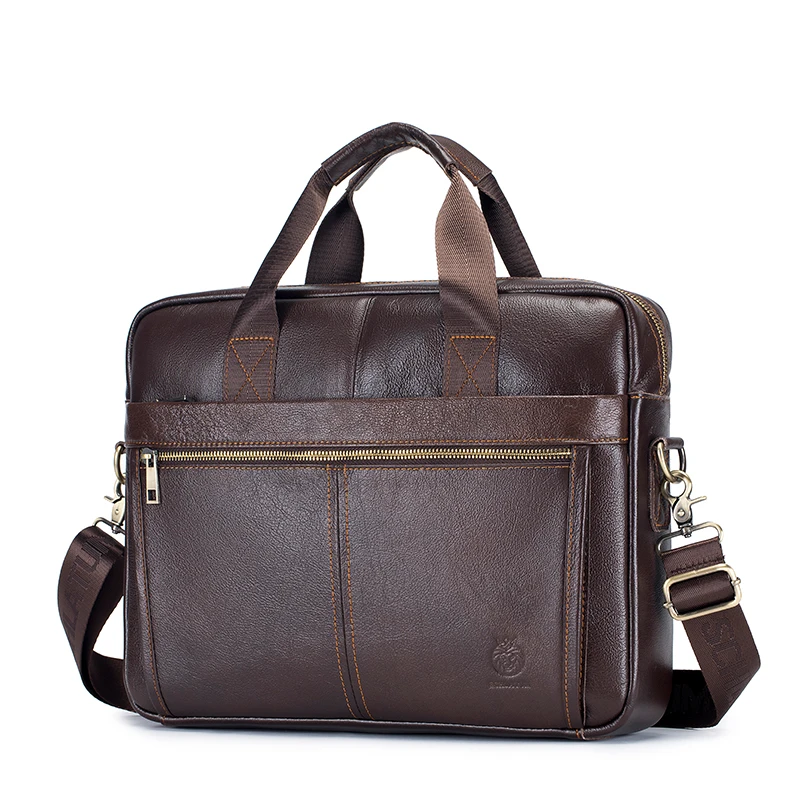
Understanding the durability of top-grain leather briefcases involves recognizing these finish differences and their impact on long-term performance. Your lifestyle and how you’ll use the briefcase should guide your finish selection—those who travel frequently may benefit from more protected leather, while office professionals might prefer the developing character of less-processed finishes.
Is a Water-Resistant Briefcase Worth the Investment?
Water damage is a common concern for leather briefcase owners, making water resistance an important consideration.
Realistic Expectations
It’s important to understand that even with treatments, leather briefcases are rarely fully waterproof. Quality leather naturally has some water resistance—especially full-grain leather with proper conditioning—but extended exposure will eventually allow moisture penetration.
Water-Resistant Options
Several approaches offer varying degrees of protection:
– Natural oils and waxes enhance leather’s inherent water resistance
– Silicone impregnation provides good water repellency with minimal effect on appearance
– Polyurethane coatings offer strong protection but may alter the leather’s natural feel
For professionals who frequently travel or commute in wet conditions, investing in leather document bags with additional water-resistant features may be worthwhile. However, these treatments typically require reapplication over time, and excessive treatment can sometimes impact leather’s ability to develop patina.
The trade-off is typically between maximum protection and natural leather qualities—more water resistance often means less natural feel and patina development.
What Makes a Briefcase’s Interior Built to Last?
While exterior quality gets most attention, interior construction significantly impacts a briefcase’s longevity.
Quality Interior Elements
- Lining material – Canvas or cotton twill offers better durability than synthetic linings
- Attachment method – Lining should be securely attached along all edges without bubbling
- Reinforced pockets – Interior pockets should have reinforced openings and secure attachment
- Structured dividers – Rigid dividers help maintain the bag’s shape and prevent content shifting
For examples of exceptional interior construction, examine our slim leather laptop briefcases that balance organization with structural integrity.
Common interior failure points include tearing at pocket openings, lining separation from the leather exterior, and collapsing dividers. Quality interiors use double-stitched seams, reinforced stress points, and properly anchored divider panels.
Should You Choose a Hard-Sided or Soft Briefcase for Longevity?
The fundamental design choice between hard-sided and soft briefcases involves different durability considerations.
Hard-Sided Briefcases
Pros:
– Superior protection for fragile contents
– Maintains shape regardless of contents
– Often features reinforced corners and edges
– Better protection from crushing in transit
Cons:
– Less flexible for accommodating odd-shaped items
– Can crack if dropped on hard surfaces
– More vulnerable to hinge failures
– Often heavier than soft alternatives
Soft Briefcases
Pros:
– Adapts to contents for maximum capacity utilization
– Better shock absorption when dropped
– Generally lighter weight
– Fewer mechanical parts to fail
Cons:
– Offers less protection from impact
– May sag or lose shape over time
– More susceptible to content damage from crushing
For a deeper examination of these differences, our comparison of classic leather briefcases provides detailed insights into which style might best suit your specific professional needs.
Conclusion: Making Your Final Selection
Selecting a truly durable leather briefcase requires balancing multiple factors:
- Leather quality – Full-grain provides the best foundation for longevity
- Construction methods – Look for reinforced stitching, quality hardware, and attention to detail
- Appropriate size and design – Choose a briefcase that suits your specific professional needs
- Care commitment – Consider your willingness to maintain the leather properly
- Value assessment – Calculate cost-per-use rather than focusing solely on purchase price
Remember that a quality leather briefcase is not merely an expense but an investment in your professional image that improves with age. When properly selected and maintained, it becomes a trusted companion throughout your career, developing character and patina that cannot be replicated in lesser alternatives.
The most durable briefcase combines quality materials, expert craftsmanship, thoughtful design, and your proper care. With the knowledge from this guide, you’re well-equipped to make a selection that will serve you faithfully for decades to come.

